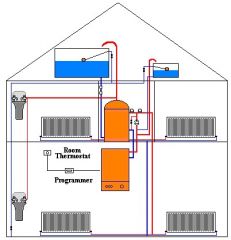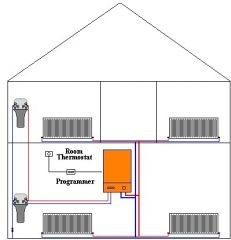Central heating can be complex to the DIY enthusiast, but hopefully these pages will help you!
First you need to decide what type of boiler you have, there are basically only three different types-
- Conventional
- Combination (combi)
- System
Conventional heating system
These boilers are only a heat source, and require a pump & control valves to be fitted separately, as well as a header tank, or sealed system kit.
Up until the early 80s the majority of heating systems installed were of the conventional, or traditional type. This requires a hot water storage cylinder and 2 cold water storage cisterns within the roof space - one for feeding the hot water cylinder and one for feeding the central heating system. This makes maintenance very difficult as the tanks often suffered from frost related problems in the roof space.
Combination boiler
Up until the early 80s the majority of heating systems installed were of the conventional, or traditional type. This requires a hot water storage cylinder and 2 cold water storage cisterns within the roof space - one for feeding the hot water cylinder and one for feeding the central heating system. This makes maintenance very difficult as the tanks often suffered from frost related problems in the roof space.
Combination or combi boilers as they are known are the most popular choice for homes today. These boilers heat domestic hot water instantly and have no storage tanks in the loft space. Combi's have everything under one cover including the pump and often come with integrated time clock and temperature control. Combination boilers include a pump & a changeover valve to switch between instantaneous hot water, and heat to the radiators. They are usually on a sealed system, but some early ones where suitable for an open system with a header tank.
System Boilers
System boilers are boilers which supply heat to a heating system, and usually a cylinder. Within the casing they contain a pump & sealed system kit. They will require a separate control valve to switch between cylinder and/or radiator supply. All three types can be found to be either condensing or non condensing. Since 2005 (Scotland 2007) all newly installed domestic boilers, (with a very small number of exemptions) need to be energy rated A or B, to achieve this they are condensing boilers. Condensing boilers remove more heat from the gases given off by the burner, and some of the fumes condense into water within the boiler, which is drained from the bottom of the boiler.
Sealed Systems
As previously explained, each boiler may be suitable for either an open system or a sealed system. Generally the older boilers will only be suitable for a open sytem , with a header tank, at a high level such as the loft. Newer boilers may be suitable for either a open system or a sealed system, or only a sealed sytem. A Sealed system, means that the system is charged with a temporary connection to the cold mains, to a pressure of around 1.3 bar (typically a third of mains pressure). To enable the boiler/system to work correctly, a sealed system, will include a pressure vessel, pressure gauge, pressure relief valve, and a fill loop, these item may be incorporated within the boiler, or fitted separately.





